One of the key issues with BRT is that you are forced to spend a lot more money to continuously upgrade the BRT right of way as passenger levels grow.
By Fraser Pollock
Published October 19, 2018
Ottawa is in the middle of a conversion away from a very successful Bus Rapid Transit (BRT) network known by its marketing name, The Transitway, towards a Light Rail Transit Network known as the O-Train.
The remaining BRT System will feed the LRT system and act as rapid transit in areas too low in passenger levels to have LRT. This article looks at the trials and tribulations that come with this process.
For most situations, Bus Rapid Transit (BRT) is generally cheaper to build than Light Rail Transit (LRT). However, it's not that much cheaper if you do it right and build actual BRT, not BRT-Lite.
BRT Lite is generally express buses operating in mostly mixed traffic, some painted bus lanes, some preemptive intersection signal control and nice bus stops. This often gets called BRT by politicians trying to build rapid transit without spending much money.
Unfortunately, most of the time, the amount of money you spend on any rapid transit system is directionally proportional to the positive passenger increases you get out of it. One of the key issues with BRT is that you are forced to spend a lot more money to continuously upgrade the BRT right of way as passenger levels grow.
LRT systems and their rights of way often start up with a much higher level of segregation and heavier infrastructure, so an LRT operation's positive effects are bigger and more immediately felt. They also can handle much higher levels of passenger growth before you have to spend more money on increasing the passenger carrying capacity of the existing infrastructure.
The main "BRT trap" is the quest for cheap rapid transit by politicians who are unwilling to understand and properly implement transit operating technology like a BRT network.
Politicians like to believe you can start off spending very little on infrastructure and slowly improve it as passenger levels grow. BRT can start off this way but very quickly, increasingly expensive BRT infrastructure upgrades and quickly rising operating costs begin to tax the entire transit system.
In fact, at a certain point, BRT stations and their rights of way have to become larger and more robust than rail infrastructure, just to carry the same number of passengers as a rail-based system. This realization was one of several key breaking points for Ottawa and it's political BRT supporters.
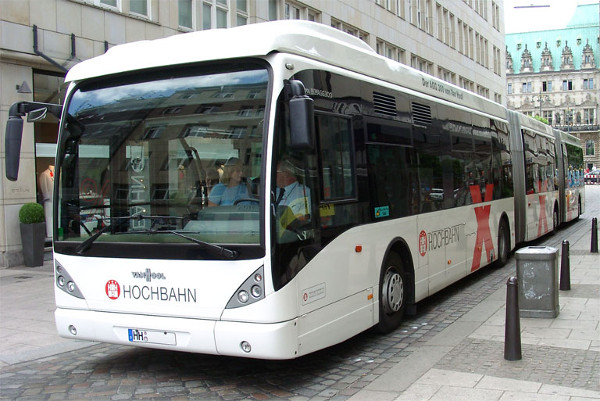
Bi-articulated Bus design by Van Hool with a length of 25 metres (Image Credit: Van Hool)
Massive BRT systems can work in China and Latin America because their human costs are much lower than in first world countries. Passengers in these countries also tolerate much higher crowding levels than first world passenger preferences and their associated safety regulations would normally allow.
Very large buses, bi-articulated and even new tri-articulated bus designs are a hallmark of these high capacity BRT systems. Several bi-articulated buses and tri-articulated bus designs, all 24-30 metres long, were advertised to North America politicians as being able to hold 270-330 passengers by several representatives of these manufacturers at a recent transit convention this past spring (May 2018) in Montreal.
When I inquired, many of these representatives sheepishly responded that in North America, it's really 170-240 passengers because of more stringent safety standards (depending on the seating arrangement and body length).
That's slightly less than the equivalent length of most Light Rail Vehicles. But oh boy, did I see several local Montreal-area politicians fall for it. (To be fair, at these conventions, you have to be careful with representatives of Light Rail Vehicle manufacturers and their promises as well.)
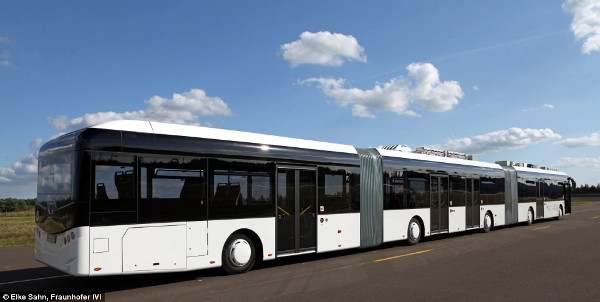
Hess of Switzerland and their Little Tram Bi-articulated Bus Series Prototype, with a length of 30 metres (Image Credit: Hess of Switzerland)
The City of Ottawa has a population of only 970,000 to provide its tax base. Around 2008, when the bus fleet was creeping up to 1,100 buses, the budget people at O.C.Transpo took notice.
Several internal O.C. Transpo reports at the time pointed out that, to accommodate future growth on the Transitway Network as well as the rest of the transit system, no fewer than two new bus garages and a fleet of 1,400-1,500 buses would be needed. Most of these buses would have to be large and expensive articulated or double-decker buses.
The budget people at O.C. Transpo soon realized that this was not affordable at all.
The Transitway Network was designed to rail building standards, not road building standards, so that at some future point, the network could be converted to rail operating technology. The advantage of LRT is that it requires a far smaller bus fleet and, by association, fewer bus drivers.
It was decided that conversion would finally begin with what became known as the Confederation Line. Construction began in the fall of 2013 and the conversion away from BRT led to the first of many planned cuts to the bus fleet.
It was first publicly announced in 2016 that 125 buses, many of them older models, will be retired, along with laying off as many as 600 unneeded bus drivers. A few months ago, O.C. Transpo announced 475 drivers will be laid off in total when Stage 1 of the Confederation Line opens (fewer than originally stated due to job shifting onto the LRT system). As many as 600 more drivers will be eliminated when Stage 2 opens in 2023-24 as well as the planned retiring of up to 150 more buses. O.C. Transpo has around 3,200 employees.
Ottawa's current bus fleet is approximately 975 buses, but around 25 are older reserve units that would never see service outside of the peak period. Many new double-decker buses are replacing articulated buses as they age out.
The double-decker bus model Ottawa is getting is the Alexander-Dennis Enviro 500, Like all heavy buses it is still hard on roads, it has an upper floor ceiling which punishes passengers above 5 foot 8 (ouch) and takes a long time to unload. However, unlike articulated buses, they hold many more passengers, can climb uphill on nearly all wet roads and don't get stuck in the snow as easily.
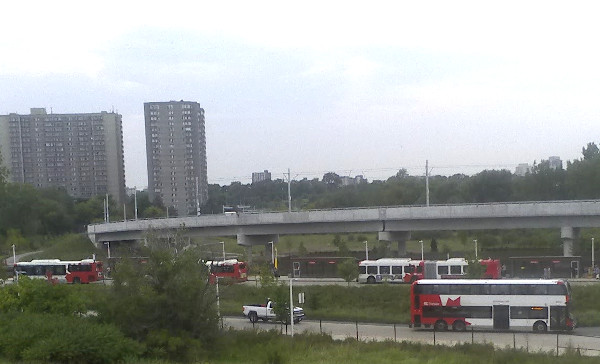
Alexander-Dennis Enviro 500 Double Deck Bus at the Hurdman LRT Station bus loop (Image Credit: Fraser Pollock)
Bi-articulated buses (24-30 metres long) and even tri-articulated bus designs (28-30 metres long), had been considered by O.C. Transpo in the mid to late 1990s, but ultimately the transit operator refused to buy them.
Transport Canada was going to require extremely expensive safety measures to run them on Ottawa's Transitway Network, even in a test program. Even the most ardent supporters of these large buses at O.C. Transpo had to admit that these larger buses had many expensive issues.
They still only last as long as normal buses do, have horrible hill climbing capability on wet pavement and need a huge fleet of snow plows because, like any articulated bus, they can't handle more than 10-12 centimetres of snow.
These large buses are so heavy that Transitway stations require extra strength concrete bus pads in the bus docking lane because their repeated travel on the same path of bus lane can obliterate a brand new asphalt surface in less than 18 months.
Unfortunately, these mammoth busses are still officially not road legal in Canada or the USA, have no North American manufacturers, and their spare parts and maintenance/training packages are stunningly expensive.
Lastly, even their bargain models start at $1.25 million per bus, which doesn't include the price of the spare parts package, maintenance training materials and instructors as well as the driver training package.
Many of these larger bi-articulated bus models can cost as much as two single articulated buses. Standard North American articulated buses are usually around 18-20 metres or 60-66 ft. long and vary in price between $600,000-$750,000 per unit.

Now-infamous 2006 photo of the problem of articulated buses and snow in downtown Hull (Image Credit: Ottawa Citizen)
Both the bi-articulated and tri-articulated bus designs are significantly shorter than the length of one 48.5 metre long Citadis Spirit Light Rail Vehicle (LRV). Ottawa will be running 2 LRVs on each train on the Confederation Line, meaning each train will be 96-97 metres long, carrying 600 passengers (300 per LRV).
The 80 metre long Stadler FLIRT Diesel Multiple Units (DMUs) will replace the current Alstom Lint 41 DMUs on the existing Trillium line in 2021.
The following two photos pictures show the scale size of Ottawa's LRVs compared to buses.
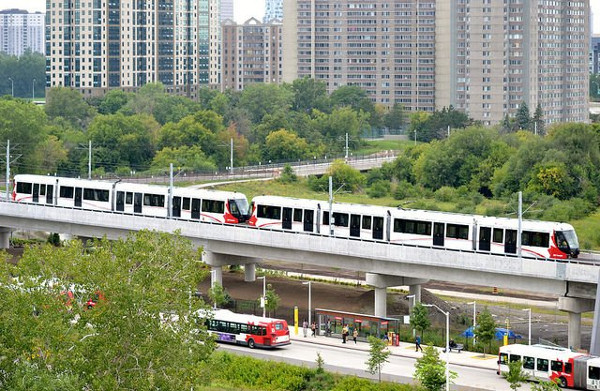
LRT scale compared to buses (Image Credit: Richard Harris/Flickr)
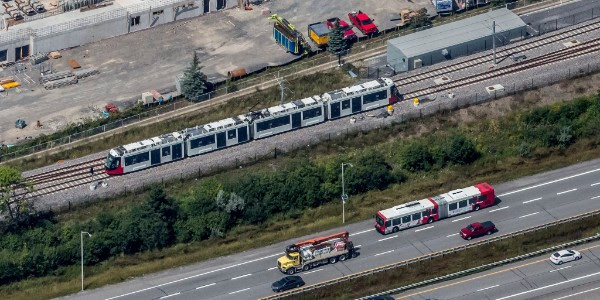
LRT scale compared to buses (Image Credit: Rideau Transit Group)
New LRV designs around the world are getting larger, leaving their bus cousins behind. Not only are new LRVs getting bigger but they are expandable as well. Both Alstom's Citadis Spirit LRVs and yes, even Bombardier's Flexity LRV design planned for several of Toronto's LRV lines (Finch West and the Eglinton Crosstown), are modular and can add more sections to increase the length of the vehicle.
Bombardier has sold many of its five-section (30 metres long) Flexity family of LRVs in Ontario. However, they can also be expanded to the 42 metre long, seven-section LRV just by adding in the new modules inside their own maintenance facility.
All these designs can operate in trains of up to three LRVs long. Edmonton has pre-ordered the seven-section model and just recently received its first LRV. The plan is to operate these LRVs in three-car trains.
Unfortunately, the Flexity Outlook vehicles used on Toronto's legacy streetcar network can't have their length expanded or use multiple vehicles coupled together into longer trains, because of the super-tight turning radii of the existing streetcar tracks.
Ottawa's Alstom Citadis Spirit LRVs, for example, can add a fifth section to the existing four-section vehicle to increase the length from 48.5 metres to 59 metres. This means the total capacity of each LRV will grow from 300 up to 370 passengers. Each of Ottawa's trains (two LRVs per train) will ultimately be 119-120 metres long, matching the station platform length expandability, and hold up to 740 passengers.
Just like with Bombardier, Alstom's LRVs can have their modifications/expansions done in the existing maintenance facilities and doesn't require the vehicle to be sent back to the factory. This built-in passenger expanding capacity is something BRT just can't do.
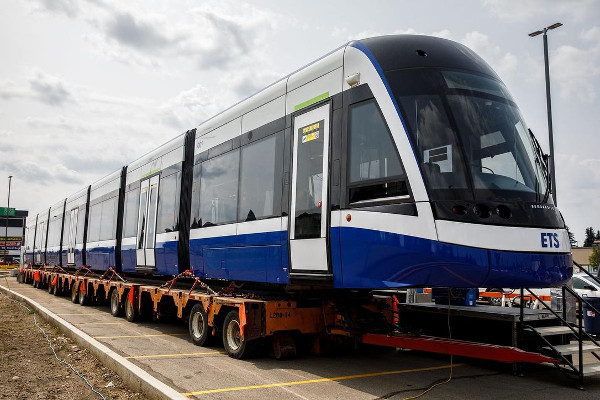
Bombardier's larger 7 section Flexity Swift Light Rail Vehicle for Edmonton with a length of 42 metres
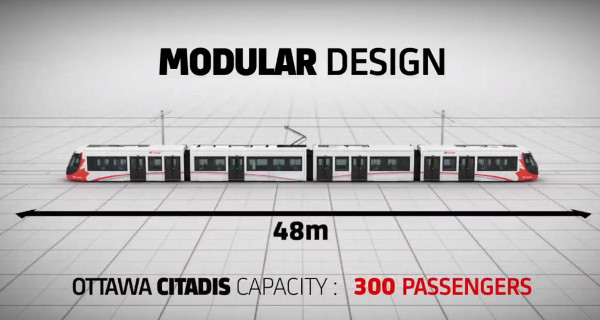
Alstom's promotional video image of Ottawa's Citadis Spirit LRV (Image Credit: Alstom)
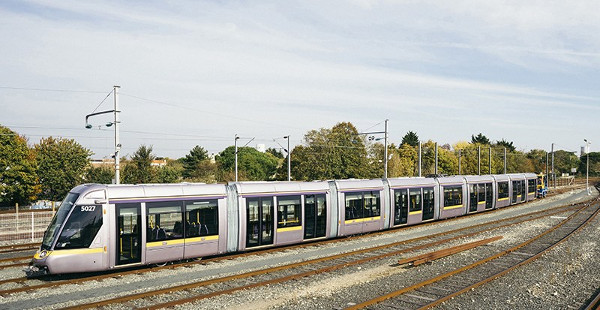
Alstom's Citadis Model 403 LRV for the streets of Dublin with a length of 55 metres (Image Credit: International Railway Journal)
CAF of Spain has produced the Urbos 100 family of LRVs, a five-section model has been ordered by Budapest, for Budapest's Line #1, a much larger nine-section LRV, which is a world record at a whopping 56.3 metres long.
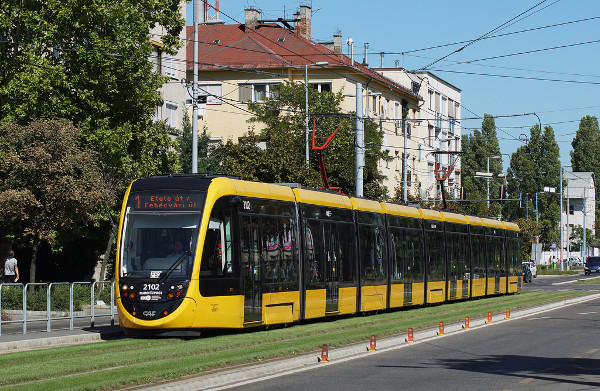
Urbos 100 LRV by CAF of Spain (Image Credit: International Railway Journal)
If we in Ottawa had stayed with BRT instead of changing to LRT operating technology, we would have had to build a massive BRT tunnel instead of an LRT tunnel in downtown. The right of way would have to be able, on opening day, to handle a peak hour passenger load of 10,500 passengers per hour per direction, travelling on 185-200 buses per hour (65 percent of them articulated).
Currently, all these buses are being replaced by only 15 trains running the entire line (again, two LRVs per train). During peak periods, they will operate at a frequency of one train every three minutes and 20 seconds.
The bus tunnel would have to have each below grade station's two-side platforms and handle no fewer than ten bus docks allowing for the simultaneous berthing of up to ten articulated buses. This means 200 metre long platforms at each station.
That's an underground mainline railway station platform, folks - imagine something almost as big as your favourite GO Train Station underground. And that's just to cover planned passenger growth to 2031.
Toronto's and Montreal's longest subway station platforms max out at 152 metres (500 ft.) and they have some of the longer subway platforms in North America. Ottawa's LRT tunnel has 120-metre-long station platforms (400 ft.) some of the longest LRT station platforms in North America, although several cities do have LRT platforms that easily exceed this length.
The Confederation Line surface station platforms in Ottawa are 90-100 metres long but are designed to be easily and cheaply expandable to 120 metres.
The BRT Tunnel stations would need a minimum of three-metre wide platforms, side platforms only because of bus door location, a 3.5 metre docking lane and a four-metre wide passing lane (these are the current Transitway Standards in Ottawa).
That's 10.5 metres of width for each direction of travel. That means a single tunnel would have to be a minimum of 21 metres or a minimum station box width of 23-24 metres or two parallel tunnels and station boxes, on two parallel streets (Albert and Slater for example) 11-12 metres wide with connecting access tunnels.
The current Ottawa LRT tunnel including platforms is only 13 metres wide, two side platforms, two tracks and a devil strip (the area between the tracks) of about one metre. The tunnel box width is about 14.5-15 metres (mostly under Queen and Rideau Streets).
The largest, deepest and most grand tunnel station is Rideau Station and is clearly less in size and scope than similar bus Transitway stations like the existing St. Laurent Transitway Station, which is the closest equivalent to many of the planned bus tunnel designs.
While not quite an underground station, it is really a trench between a mall and a major highway with a roof. The upper surface of the roof is the local bus platform. You begin to understand the size and scale needed for large below-grade bus rapid transit stations, especially when compared to the size of the LRT equivalent in Ottawa.
In fact, the tunnel box width of the single Bus tunnel design would have allowed for four tracks and two side platforms as well as one centre platform! Each platform would be 2.5-3 metres wide. You only have to look at pictures of the LRT stations under construction at Tunney's Pasture and see how much wider the former BRT right of way was in comparison.
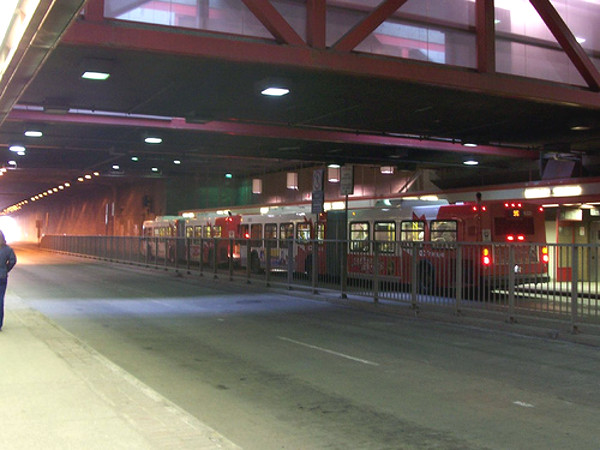
St. Laurent Transitway Station before conversion to LRT, looking east. (Image Credit: O.C. Transpo)
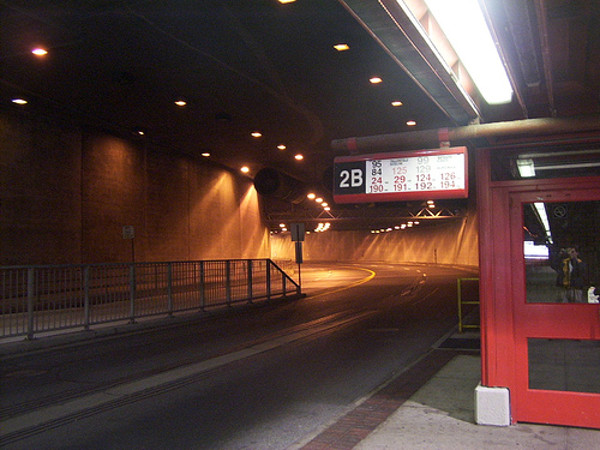
St. Laurent Transitway Station looking west. (Image Credit: O.C. Transpo)
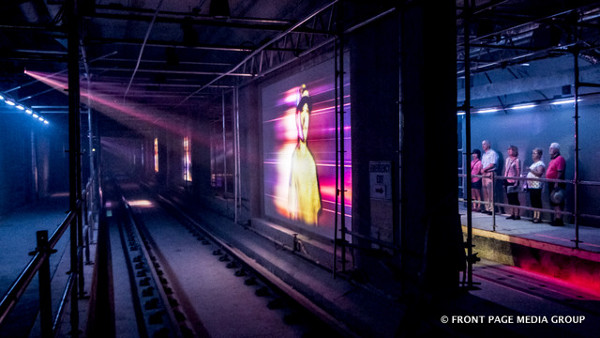
Lyon LRT Station platform level still under construction but graphically showing the station's width during the Kontinuum Sound and Light Show in 2017 during the Canada 150 celebrations. (Image Credit: Front Page Media Group)

An image of a completed Lyon LRT Station platform level, notice the size difference between it and its bus tunnel equivalent. (Image Credit: Rideau Transit Group)
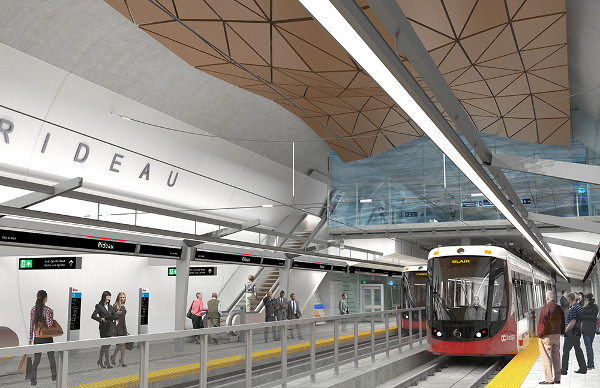
Rideau Station is the most spacious of all the below-grade LRT Stations in Ottawa because of the removal of the ceiling and most of the concourse level above the station platform level. (Image Credit: Rideau Transit Group)
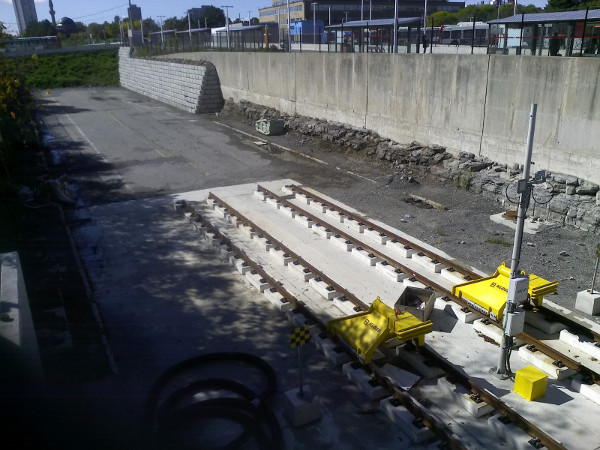
The West end of Tunney's Pasture Station as well as the end of track. Notice how wide the former BRT right of way needed to be compared to the LRT right of way. (Image Credit: Fraser Pollock)
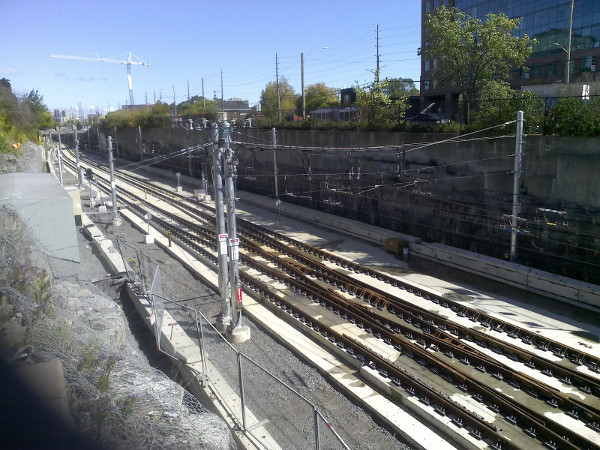
The east side of Tunney's Pasture and extra space of the former BRT right of way. (Image Credit: Fraser Pollock)

West end of Tunney's Pasture Transitway Station looking east just after closure, June 24, 2016 (Image Credit: Skyscraper Page)

Tunney's Pasture LRT Station looking west October 4, 2018 (Image Credit: Fraser Pollock)
What was not generally appreciated by the supporters of the Downtown Bus Tunnel in Ottawa was the work that would have to be completed to upgrade the capacity of the existing BRT stations outside of the core to accept the constantly growing numbers of Transitway buses.
No fewer than ten, and possibly up to 12 stations outside of the tunnel, would require huge increases in platform lengths - many would have to have their length doubled.
Many stations would also require big improvements in their ability to handle passengers, such as new entrances/exits, more and or improved elevators/escalators as well as more stairwells. Many of the existing stations would also require very much improved local bus platforms. There were kilometres of expensive concrete upgrades and or conversions to concrete from asphalt at many of the station docking lanes. Just this desperately-needed work alone on the stations outside of the tunnel was budgeted at over $1 Billion.
To add even more costs, many of the older Transitway stations would still have to be upgraded, LRT or no LRT.
Tunney's Pasture, Lees, and Hurdman Transitway stations all were 33-35 years old and in desperate need for outright replacement due to crumbling or cracked concrete supporting structures and the complete rusting through of the red steel tubes (originally knick named "Tinker Toy"), which held the station's large glass panels and the bulk of the stations roof structures all needed removal and replacement. The manufacturer of these tubes went out of business in the 1990s.
All this is just for Stage 1 LRT work. One of the concrete elevator shafts at Tunney's Pasture was so close to structural collapse that a construction engineer confidentiality told me, "They didn't need to do much to it to knock it down. Even without LRT it was going to have to come down in a year or two anyway!"
Stage 2 LRT work required or still requires knocking down Queensway Station, due to the widening of the Queensway (Highway 417). Carling and Westboro stations have to go due to age and structural issues.
The original Baseline Station was already torn down so that a new academic building at Algonquin College could be built. A hollowed out underground LRT section is complete as well as a temporary surface station, with two 180-metre-long side BRT platforms.
Bayshore Station (built in the early 2000s) and Moodie Station (just finished in October of 2017) will need major modifications. Iris, Montreal Road and Dominion stations are just platforms with a bus shelter, so no big effort required there to take them down and replace them with something more substantial.
Greenboro, Walkley and South Keys Transitway stations will require modifications and upgrades due to extensive Trillium Line work even though they only date from the mid-1990s.
Westboro Station opened in 1985 along with Tunney's Pasture. Notice that most of its rooftop glass panels were replaced with plastic because of issues with the fasteners detaching the glass from the red steel tube supports. When the snow melted and fell off the roof, the glass sometimes came with it.
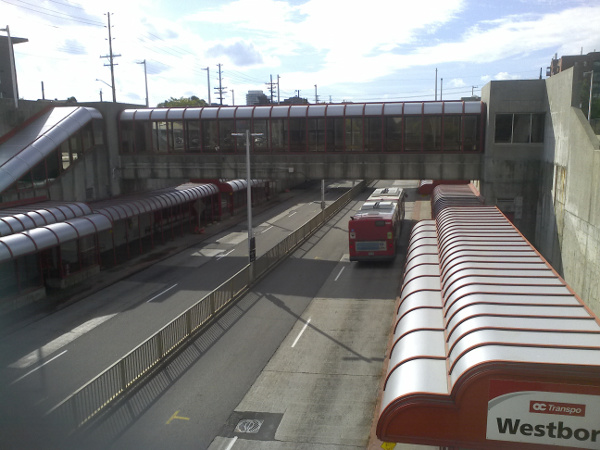
Plastic panels on Westboro Station roof (Photo Credit: Fraser Pollock)
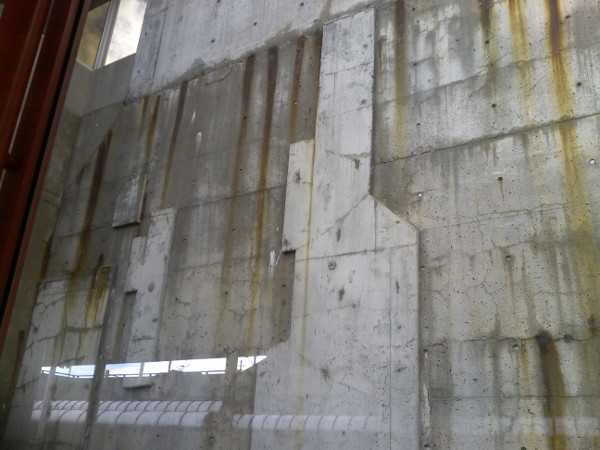
Aging Concrete Retaining Wall at Westboro Station (Photo Credit: Fraser Pollock)
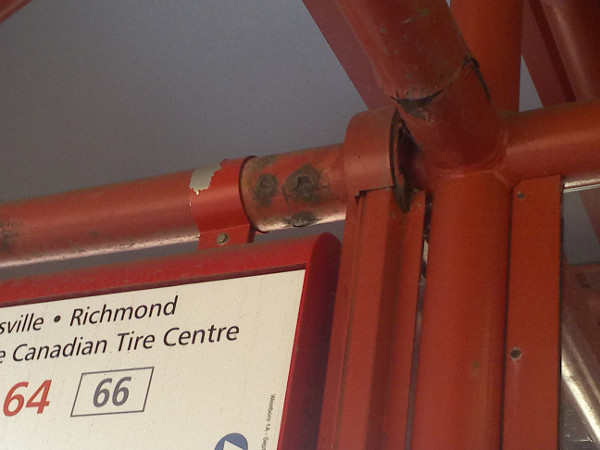
The red steel structural tubes a.k.a. "The Tinker Toy" rusting through at Westboro Station (Photo Credit: Fraser Pollock)
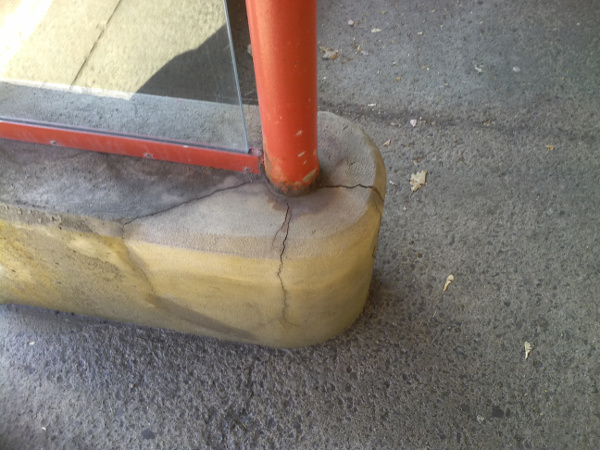
Many structural elements need significant repair at Westboro Station (Photo Credit: Fraser Pollock)
Many of the bridges on the Transitway network were in great need of work. The Mann Avenue bridge required outright replacement. The key but aging Transitway bridge over the Rideau River between Lee's and Hurdman stations needed seven months of repairs and upgrades, twice the length of time O.C. Transpo thought it originally needed.
The Transitway viaduct, which starts east of Tunney's Pasture going over Bayview Avenue toward Bayview Station, took a year of repairs.
The bridge over the O-Train right of way at Bayview Station was in far worse condition than believed, so much so that it collapsed as they were tearing it down, destroying a front-end loader in the process. Thankfully no one was hurt.
This was just for Stage 1. No fewer than six new bridges will be needed, many as replacements for existing Transitway bridges. Another 11 are in need of serious repair work for the Stage 2 LRT project. At least 1 temporary bailey bridge will be used during the construction of the Stage 2 LRT project.
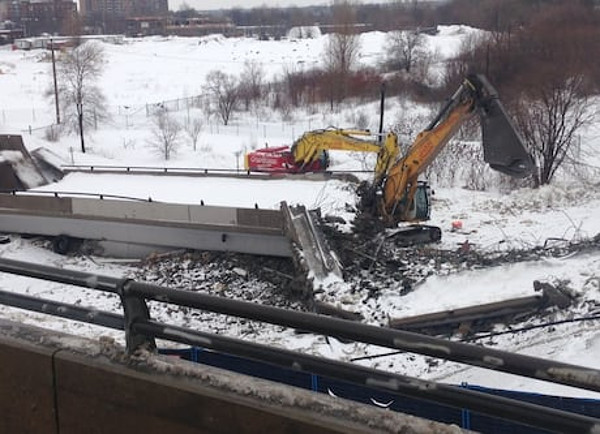
Overpass over Bayview O-Train Station collapsed when it was being dismantled in March 2016 (Photo Credit: CBC Ottawa)
Diagnosing the issues around BRT and LRT is relatively easy. Conversion of the Transitway to the Confederation Line is the challenging part. The story and process were unique because no one in North America had ever completely converted 12.5 km of a successful BRT line to an LRT line before. The process is long and quite involved.
By Haveacow (registered) | Posted October 19, 2018 at 10:44:44
This Alstom promotional video shows the expandable nature of their modern modular Light Rail Vehicle, the Citadis Spirit LRV.
By ScreamingViking (registered) | Posted October 21, 2018 at 17:18:27
Great article. Thank you!
This sentence especially applies well to the Hamilton debate: The main "BRT trap" is the quest for cheap rapid transit by politicians who are unwilling to understand and properly implement transit operating technology like a BRT network.
Unwilling to understand, unable to understand in a few cases... definitely unwilling to read more than a few bullet points unless they fit the politician's preconceived notions of transit.
Much has been discussed about development potential. I really wish the CAPACITY issues had been more strongly emphasized, especially with regard to future transit demand, even if starting with a true BRT.
A more extensive BRT system can perhaps be built for the money budgeted for the B-Line LRT, but at a cost of under-serving the main transit corridor in the city (or a cost of implementing much more expensive solutions to make sure the main transit corridor can handle the needs)
You must be logged in to comment.
There are no upcoming events right now.
Why not post one?